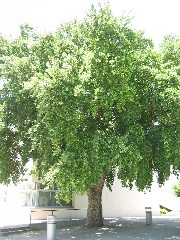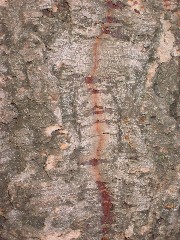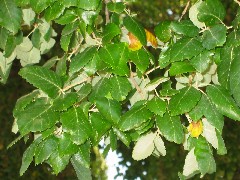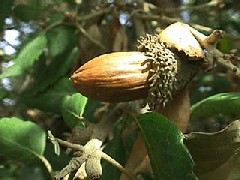Cork Oak
Quercus suberFamily: Fagaceae
Podcast Script
|
|
Classification:
• Angiosperm, Dicot, evergreenSize:
• Can grow over 65 feet in height, although in their native environment they often appear somewhat stunted.• The leaves are 2-3 inches long.
• Seasonal growth is between 24-36 inches.
Identifying Features:
• Jagged and corky bark that can grow to considerable thickness.• Bark is light gray in color, with deep furrows of reddish brown.
• Leaves are weakly lobed and coarsely toothed while being dark green above and gray below.
• Leaf margins often curve downward.
• The tree is an oval, rounded or umbrella like in shape with branches and leaves spreading out an extensive area.
• Evergreen.
Location/Habitat:
• Native to Southwest Europe and Northwest Africa.• Hardy and can survive in Sunset Zones 5-16 and 18-23 or USDA Hardiness Zones 8-10.
Flower/Fruit/Reproduction:
• The flowers are monoecious and appearing in spring.• The males are slender, yellow-green 2-3 inch catkins; females are very small and in clusters of 2 to 4 in leaf axils.
• The fruit are brown acorns of .5-1.5 inches in length, appearing in fall to winter.
• Acorn shape is narrow and oblong, with a loose scaly cap covering approximately 1/2 of the fruit.
• The fruit comes in prolific numbers.
Water/Sun Requirements:
• The Cork Oak can survive in moist to dry soil, although it requires good drainage.• Full sun to partial shade is suitable.
Special Adaptations:
• Drought tolerant.• Fairly tolerant of different soil types and soil pH.
• Can survive in clay, loam or sand that is highly acidic to slightly alkaline in pH.
• Resistant to Verticillium although susceptible to Phytophthora and Root Rot.
• Resistant to fire.
Other Info:
• The largest commercial growth of Cork Oak is in Portugal.• The cork used in domestic products, such as wine bottle stoppers and bulletin boards, are produced from the bark of this tree.
• The Cork Oak is most widely cultivated in Spain, Portugal, Algeria, Morocco, France, Italy, and Tunisia.
• The European cork industry produces around 340,000 tons of cork a year, with a value of €1.5 billion.
• Longevity of the tree is greater than 150 years.
Reference Sources/Links:
• http://www.factmonster.com/ce6/sci/A0813563.html• http://en.wikipedia.org/wiki/Cork_oak
• http://www.fao.org/docrep/x1880e/x1880e08.htm
• http://davesgarden.com/pf/go/54410/index.html
• http://selectree.calpoly.edu/treedetail_all.lasso?rid=1263
• http://www.cnr.vt.edu/DENDRO/dendrology/syllabus2/factsheet.cfm?ID=553
Created by: Edward T. 2007



